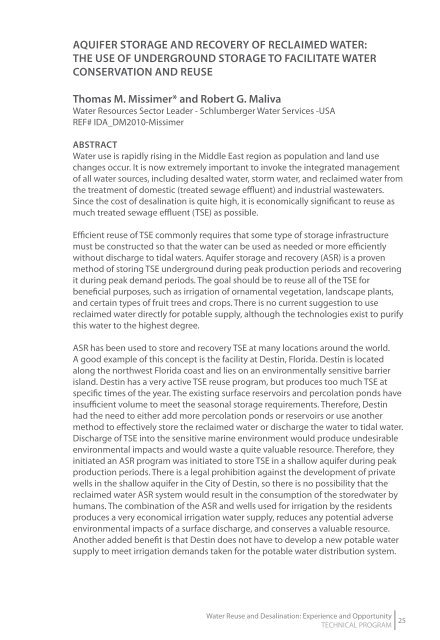View Technical Program - Levant Desalination Association
View Technical Program - Levant Desalination Association
View Technical Program - Levant Desalination Association
Create successful ePaper yourself
Turn your PDF publications into a flip-book with our unique Google optimized e-Paper software.
AQUIFER STORAGE AND RECOVERY OF RECLAIMED WATER:<br />
THE USE OF UNDERGROUND STORAGE TO FACILITATE WATER<br />
CONSERVATION AND REUSE<br />
Thomas M. Missimer* and Robert G. Maliva<br />
Water Resources Sector Leader - Schlumberger Water Services -USA<br />
REF# IDA_DM2010-Missimer<br />
ABSTRACT<br />
Water use is rapidly rising in the Middle East region as population and land use<br />
changes occur. It is now extremely important to invoke the integrated management<br />
of all water sources, including desalted water, storm water, and reclaimed water from<br />
the treatment of domestic (treated sewage effluent) and industrial wastewaters.<br />
Since the cost of desalination is quite high, it is economically significant to reuse as<br />
much treated sewage effluent (TSE) as possible.<br />
Efficient reuse of TSE commonly requires that some type of storage infrastructure<br />
must be constructed so that the water can be used as needed or more efficiently<br />
without discharge to tidal waters. Aquifer storage and recovery (ASR) is a proven<br />
method of storing TSE underground during peak production periods and recovering<br />
it during peak demand periods. The goal should be to reuse all of the TSE for<br />
beneficial purposes, such as irrigation of ornamental vegetation, landscape plants,<br />
and certain types of fruit trees and crops. There is no current suggestion to use<br />
reclaimed water directly for potable supply, although the technologies exist to purify<br />
this water to the highest degree.<br />
ASR has been used to store and recovery TSE at many locations around the world.<br />
A good example of this concept is the facility at Destin, Florida. Destin is located<br />
along the northwest Florida coast and lies on an environmentally sensitive barrier<br />
island. Destin has a very active TSE reuse program, but produces too much TSE at<br />
specific times of the year. The existing surface reservoirs and percolation ponds have<br />
insufficient volume to meet the seasonal storage requirements. Therefore, Destin<br />
had the need to either add more percolation ponds or reservoirs or use another<br />
method to effectively store the reclaimed water or discharge the water to tidal water.<br />
Discharge of TSE into the sensitive marine environment would produce undesirable<br />
environmental impacts and would waste a quite valuable resource. Therefore, they<br />
initiated an ASR program was initiated to store TSE in a shallow aquifer during peak<br />
production periods. There is a legal prohibition against the development of private<br />
wells in the shallow aquifer in the City of Destin, so there is no possibility that the<br />
reclaimed water ASR system would result in the consumption of the storedwater by<br />
humans. The combination of the ASR and wells used for irrigation by the residents<br />
produces a very economical irrigation water supply, reduces any potential adverse<br />
environmental impacts of a surface discharge, and conserves a valuable resource.<br />
Another added benefit is that Destin does not have to develop a new potable water<br />
supply to meet irrigation demands taken for the potable water distribution system.<br />
Water Reuse and <strong>Desalination</strong>: Experience and Opportunity<br />
TECHNICAL PROGRAM 25




